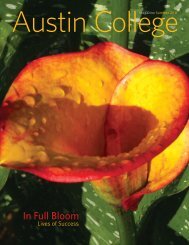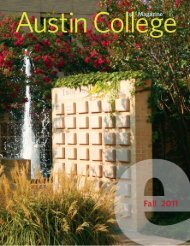Winter 2012 - Austin College Magazine
Winter 2012 - Austin College Magazine
Winter 2012 - Austin College Magazine
Create successful ePaper yourself
Turn your PDF publications into a flip-book with our unique Google optimized e-Paper software.
A C E N T U R Y<br />
Laboratory Fees for 1913-14<br />
Sophomore Chemistry . . . . . . . . . . . .$5<br />
Junior Chemistry . . . . . . . . . . . . . . .$10<br />
Senior Chemistry . . . . . . . . . . . . . . .$10<br />
Junior Physics . . . . . . . . . . . . . . . . . . .$3<br />
Senior Physics . . . . . . . . . . . . . . . . . .$2<br />
Biology . . . . . . . . . . . . . . . . . . . . . . .$7<br />
Tuition was $96 per semester.<br />
Biology Curriculum, 1922-1923<br />
Systematic Zoology [Hegner, General Zoology]<br />
Zoology, Echinoderms-Arthropods<br />
Zoology, Vertebrates (Pre-Meds)<br />
General Botany [Densmore’s <strong>College</strong> Botany]<br />
Histology<br />
Embryology – Fowl<br />
Embryology – Frog and Pig [Prentiss and Arey’s<br />
Embryology]<br />
Physiology<br />
Genetics, Heredity, and Eugenics<br />
Martin’s Human Body<br />
As <strong>Austin</strong> <strong>College</strong> prepared to celebrate a century of science education, faculty<br />
scanned the history books and <strong>College</strong> Archives to gain a perspective on what the last<br />
100 years of science education at <strong>Austin</strong> <strong>College</strong> has entailed. They discovered a<br />
faculty who had been dedicated to teaching and stories of young men and women<br />
committed to learning and taking their education into their own communities as<br />
researchers, professors, business leaders, and physicians—much as today’s young<br />
men and women will do.<br />
1849-1910<br />
In 1853, the <strong>College</strong> established an uncommon relationship with the Smithsonian<br />
Institute in Washington, D.C. In exchange for data on Texas weather and native Texan<br />
plant and animal specimens, the Smithsonian provided the <strong>College</strong> materials, books,<br />
science pamphlets, maps, and mineral specimens, giving the <strong>College</strong> a head start on<br />
a science curriculum.<br />
Additionally, <strong>College</strong> founder Dr. Daniel Baker was given “not less than $500 for<br />
chemicals and apparatus” on his fourth trip to Washington, D.C., and New York. By<br />
the late 1880s, the sciences were staffed with well-trained professors such as George<br />
Snedecor in mathematics. Snedecor discovered a process he called the “F<br />
Distribution,” which became a key element in the analysis of statistical variance.<br />
The first Bachelor of Science degrees were offered in 1903 to those students who<br />
took a heavier concentration of courses in the sciences. Courses of the time included<br />
surveying and navigation, differential and integral calculus, hydrodynamics,<br />
electricity, and magnetism.<br />
1910-1920<br />
There was a minor crisis among the faculty in the 1910s, when a student studying for<br />
ministerial work complained to the <strong>College</strong> president that evolution was included as<br />
a scientific fact in one of the textbooks. All the science faculty members were called in<br />
for questioning, and it was discovered that the book was owned by Dr. Harry Sharp,<br />
a physics professor. He voluntarily resigned when questions about his lack of religious<br />
faith displeased the heavily ministerial Board of Trustees.<br />
That decade was one of great change within the <strong>College</strong>. The sciences expanded to<br />
include engineering curriculum, and the increase in courses led to the founding of a<br />
separate department for chemistry and the combined department of biology and<br />
physics. The lone classroom building was remodeled to meet the growing need for<br />
space, but before the project was complete, a homesick 15-year-old student arsonist<br />
burned Old Main in 1913. All the materials, books, and science equipment were lost in<br />
the fire.<br />
Undaunted, President Clyce began fundraising efforts immediately, and<br />
Thompson Hall was constructed by the end of the year, replete with “modern science<br />
laboratories.” In addition to having gas power as a backup, the new building was<br />
equipped with the latest modern advancement: electrical power.<br />
<strong>Austin</strong> <strong>College</strong> already was developing a reputation as a leader in pre-medical<br />
studies. One of the first alumni to earn his medical degree was Mandred W. Comfort,<br />
who graduated in 1916 and became a surgeon with the famous Mayo Clinic. The<br />
<strong>College</strong> began offering specific pre-medical courses in 1919, and already had started<br />
a separate department for geology and physics. The geology courses were popular;<br />
on Saturdays, students had the opportunity to scour riverbeds in Texas and<br />
Oklahoma, looking for fossils.<br />
18 | <strong>Austin</strong> <strong>College</strong> <strong>Magazine</strong> <strong>Winter</strong> <strong>2012</strong>





